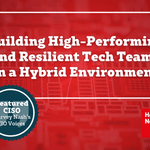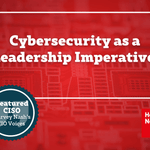Harvey Nash USA, Vice President of Strategic Partnerships Michael Goldberg discusses how businesses can build workforce confidence with in their employees. This article first appeared on Manufacturing.net. Automation, digitization, and artificial intelligence can sound alarming to workers who fear the possibility of being replaced by advanced technology. While these concerns have some merit, the reality is more complicated. In fact, the World Economic Forum predicts �that by 2025, 85 million jobs may be displaced by a shift in the division of labor between humans and machines, while 97 million new roles may emerge that are more adapted to the new division of labor between humans, machines and algorithms.� The future of manufacturing is automation � it increases efficiency, streamlines processes, improves quality, and delivers consistency. It can also decrease a company�s carbon footprint by doing more with less space and waste. But, many workers overestimate how quickly technology is taking over the plant floor. The transition in the U.S. has been especially slow � researchers at MIT found that slightly less than 10 percent of manufacturers have deployed industrial robots due to design limitations, workforce challenges and high integration costs. Workers also underestimate their own potential to adapt to automation, which can lead to a confidence gap and job insecurity. Manufacturers, especially small and mid-sized organizations that are further behind in the automation process, have the opportunity to take a leadership role in the transition to Industry 5.0. Each company will have its own unique set of circumstances and challenges to address depending on the products produced, the size and location of its facilities, workforce makeup, leadership approach and more. But, they can all strive to ease workers into the next phase of manufacturing by addressing an understandable resistance to technology advancements and helping employees overcome their insecurities through skills training programs. Start with a Needs Assessment Understanding exactly where the organization stands when it comes to automation will help employees become more accepting of the transition. A thorough needs assessment, which is a systematic review of the company�s technology landscape, will help identify what�s in place, what may be implemented in the future, and where there are skills gaps. One overarching theme is to involve employees in each phase of the process. The first step is to document all of the technology currently in place within the organization and determine what systems are performing well, where there�s opportunity to access more functionality and where upgrades are necessary. It may also reveal that some solutions need to be completely retired and replaced with newer technology. Surveying employees who regularly use the solutions will indicate if there are deficiencies such as outdated software, complicated interfaces or slow processing systems. If a new tech solution is needed, it�s critical to pinpoint what business requirements it needs to meet, and then evaluate options against those criteria. In many cases, the most expensive or flashy replacement is not only unnecessary, it can do more harm than good if it�s overly complicated. Conducting research is important, including reading online reviews and talking to others in the industry about their experiences. End user employees should test the different features and functionalities to determine if the solution will achieve the required results. And if the process of selecting a new solution is overwhelming, an outside technical expert can be a valuable investment to help make the right decision and avoid a costly mistake. Once there�s a catalog of tech assets, it�ll be easier to understand what skills are required to optimize each solution. Team leads and managers can help identify skills gaps in their departments. Employee capabilities can also be evaluated through surveys, interviews and hands-on testing that will show how adept they are at using the actual machines and software, and where they need training. Examples of tech assessments include coding challenges, software troubleshooting and machine part assembly. Dedicate Resources to Build a Training Program A Visual Components survey of manufacturing decision-makers in the U.S., UK, Germany and France found that 55 percent of companies are not investing in new technology training, blocking progress in Industry 5.0 as workers are not being upskilled. One barrier is that many managers are struggling just to find and retain workers; making developing and overseeing a training program virtually impossible. In order to be successful, companies need to commit to an across the board investment in training, including identifying an employee who can dedicate time to upskilling and reskilling workers. Some responsibilities of this role might include: Research different options, including reaching out to community colleges and vocational schools to understand the different coursework offered and if new programs need to be developed. There�s also a wealth of online options that provide software training and certification courses. One helpful organization is the Manufacturing Extension Partnership (MEP), which provides small and medium-sized manufacturers with a wide range of services including workforce development. Determine when it�s worth investing in supplier training. To save costs, some organizations will select a small group of �super users,� or employees that have a natural aptitude and interest in learning new technology, to receive the training. Upon completion, they can be sent into the workforce to train other employees. Ensure that employees are holding up their end of the bargain. Training is an investment that needs to be taken seriously by both sides. There should be clear communication about the company�s goals and expectations of the employee. This includes a commitment that they will complete courses in a timely manner, obtain the necessary certifications and raise a red flag if they�re struggling with the work. Build a mentorship program that delivers personalized guidance to employees from experienced professionals. Mentors can help navigate day-to-day experiences, as well as identify upskilling opportunities, suggest appropriate courses and guide employees through the training to ensure successful completion. Typically, it�s most effective to have a mentor that is not a direct manager and is three to five levels above the employee so they can be seen as a role model of future career opportunities. Start training for the future-state. It�s important to get the foundational piece down first but once employees are comfortable with existing technology it�s time to draw a five to 10-year road map for them. Not only does this prepare them for upcoming tech integrations, but it�ll show them that they�ll be a valued contributor to the transition. It can also help recruit new employees, especially Gen Z workers who want to know they�re entering a field that provides a long-term career path. Automation provides manufacturers with a competitive advantage by enabling them to create a productive and safe workplace that produces high-quality and innovative products. But it can only be successful if employees and machines are working in harmony toward shared goals. This means organizations need to rethink how they approach implementing advanced technology solutions and instead of taking a top-down approach, make every effort to involve employees throughout the journey. Michael Goldberg is Vice President, Strategic Partnerships for Harvey Nash USA, a full-service talent management firm specializing in technology positions.
Building Trust and Skills in the Age of Automation
You might also like
Get in touch
If you're looking to secure your next role or make your next best hire, we'd love to help. Get in touch to speak with one of our consultants today




